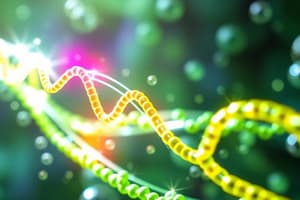Podcast
Questions and Answers
What defines an endergonic reaction?
What defines an endergonic reaction?
- It requires an input of energy. (correct)
- It releases energy.
- It occurs spontaneously without energy input.
- It produces adenosine triphosphate.
What is the primary function of ATP in cellular processes?
What is the primary function of ATP in cellular processes?
- It catalyzes chemical reactions directly.
- It provides a unit of energy for the cell. (correct)
- It serves as a genetic material.
- It acts as a long-term energy storage molecule.
How do enzymes affect activation energy in biochemical reactions?
How do enzymes affect activation energy in biochemical reactions?
- They increase the activation energy needed.
- They lower the activation energy needed. (correct)
- They have no effect on activation energy.
- They eliminate the need for activation energy altogether.
Which factor can negatively impact enzyme function?
Which factor can negatively impact enzyme function?
What happens during competitive inhibition?
What happens during competitive inhibition?
Which of the following best describes a coenzyme?
Which of the following best describes a coenzyme?
What is the effect of feedback inhibition on enzyme activity?
What is the effect of feedback inhibition on enzyme activity?
What distinguishes a reduction reaction from an oxidation reaction?
What distinguishes a reduction reaction from an oxidation reaction?
Flashcards are hidden until you start studying
Study Notes
Energy
- The capacity to do work
- Can be converted from one form to another
- Some energy is always lost during conversions
Endergonic Reactions
- Require an input of energy
- Products contain more energy than the reactants
Exergonic Reactions
- Release energy
ATP
- Adenosine triphosphate
- Composed of adenosine and three phosphate groups
- Stores small amounts of energy for short periods of time
- The unit of energy used by cells
- Phosphate groups are held on with high energy bonds
- Phosphate groups are released through hydrolysis
- The removal of a phosphate group produces ADP
- Phosphate groups can be transferred to other molecules, a process called phosphorylation
Enzymes
- Proteins
- Catalysts
- Speed up reactions without being altered themselves
- Lower the activation energy of a reaction
- Have specificity
Enzyme Action
- Enzymes have an active site with a shape that matches a specific substrate
- The substrate is the substance that the enzyme acts on
- The substrate binds to the active site of the enzyme
Enzyme Function
- Factors affecting enzyme function include:
- Optimal temperature
- Optimal pH
- Concentration of salts and other chemicals
- Cofactors and coenzymes, which help the enzyme catalyze a reaction
- Cofactors are often metal ions
- Coenzymes are often vitamins
Enzyme Regulation
- Several mechanisms regulate enzyme function:
- Amount of enzyme
- More enzyme = greater rate of reaction
- Competitive inhibition: Two substances compete to bind to the active site (substrate and inhibitor)
- When the inhibitor is bound, the substrate cannot bind.
- Non-competitive inhibition: The inhibitor binds to a site that is not the active site, changing the enzyme’s shape.
- Feedback inhibition: The final product inhibits an enzyme, shutting down a series of reactions
- Amount of enzyme
Oxidation & Reduction (Redox Reactions)
- Oxidation – loss of electrons from a substance
- Reduction – addition (gain) of electrons to a substance
- Hydrogen atom = 1 electron and 1 proton
Studying That Suits You
Use AI to generate personalized quizzes and flashcards to suit your learning preferences.




